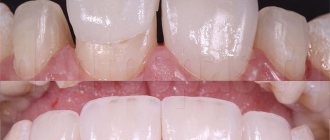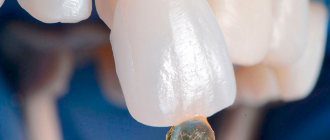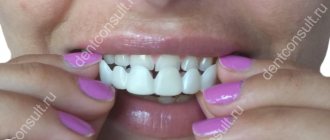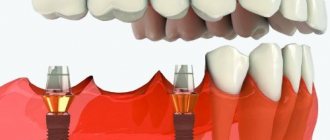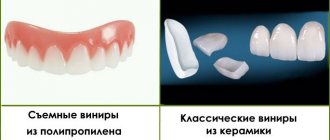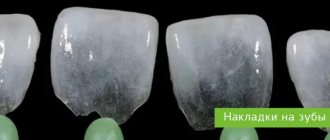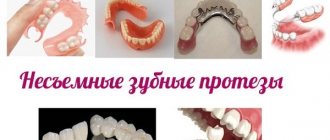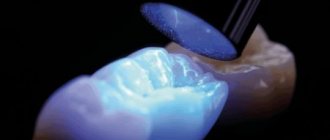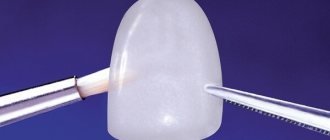Once upon a time, our ancestors made dishes from ceramics, but today they can be used to make the thinnest plates that can turn a smile into a real work of art. We are talking about installing ceramic veneers, with the help of which it is possible to give teeth an ideal shape and aesthetic shade, while preserving their natural transparent structure. Magomed Umatgireevich Dakhkilgov, chief physician of the GERMAN IMPLANTOLOGY CENTER, told us about all the nuances of the unique procedure.
What are porcelain veneers?
A ceramic veneer is a thin plate of high-quality ceramics approximately 0.3 - 0.5 millimeters thick. The microprosthesis is fixed to the external tooth surface using special cement. Veneers correct the color, shape and slight curvature of teeth, trema and diastema, as well as crowding.
Photos before and after installation of ceramic veneers at the Research Center. Works by Avetisyan R.A., Dakhkilgov M.U., and Karneev A.N.
What are the disadvantages of veneers that need to be taken into account?
The main disadvantage is that they cannot be removed by yourself or even dismantled without damaging them. These are not braces. Well, the enamel needs to be prepared - yes, in a thin layer, only 0.5-0.7 mm, but even such an impact can bring negative consequences. Protection against pathogens, aggressive environments, mechanical and chemical factors deteriorates.
As a result, you cannot simply remove the plates - after this you need to either attach new ones or use some other method of restoring the beauty of your smile.
Existing pathologies should also be taken into account. In severe cases, microprostheses can provoke a change in diction. Another disadvantage of veneers lies in the fact that the teeth protruding from under them will still be stained and darken, which means that over time they will become different in color, at least on the inside. To prevent this aesthetic problem, you need to change your menu and stop smoking. Although giving up bad habits is, in principle, a sound idea, even if everything is fine with a smile.
These overlays must be fixed by a specialist, because in case of non-compliance with the technology or errors, the following unpleasant consequences are possible:
- Loose fit and, as a result, darkening of the plate.
- Protruding edges that can cause injury to the soft tissues of the oral cavity.
- A manifestation of hypersensitivity, indicating either poor enamel cleaning or the development of caries.
In addition, you can break off a piece of such a microprosthesis if you thoughtlessly bite into too hard food.
Advantages of ceramic veneers over composite ones
Unlike composite ones, the advantages of ceramic onlays are obvious to any specialist. And here's why: even the most expensive composite is actually plastic; it quickly loses its shine, darkens and delaminates over time. This means that composite veneers are less durable and aesthetically pleasing. Ceramic veneers, on the contrary, cannot be stained, do not change their shape, retain their relief and have the shine of natural teeth. All this makes restorations an excellent tool for creating an ideal smile, without which modern aesthetic dentistry is unthinkable. The only disadvantages of ceramic veneers are the price and complexity of installation, which require the patient to carefully approach the choice of a dental clinic.
How to navigate the names
When choosing records, first of all look at:
- material – ceramics, zirconium, plastic, composite;
- thickness – the method of preparing a dental unit depends on it; the thinner the model, the less turning;
- manufacturer - give preference to a well-known brand whose products are reliable, safe, and time-tested.
In most cases, onlays are placed in the smile area - on the incisors, canines, and premolars. But they can also be fixed to molars. If the tooth is severely damaged, the standard option is not suitable. In this case, the product is installed 180° or 360°, covering the crown on all sides.
What is a classic veneer
This is the name for plates that are fixed only at the front. To attach them, the tooth is ground down, removing the enamel and part of the dentin (hard tissue). This is explained by the fact that:
- The structure of the enamel prevents high-quality adhesion, so it must be removed.
- Dentin needs to be prepared if the thickness of the plate is more than 0.5 mm. Otherwise, the bite will be disrupted, the shape of the face will change, and the patient will feel discomfort.
When you don’t want to sharpen your incisors, canines and molars too much, take lumineers. To fix them, only the enamel is removed.
How is a ceramic veneer different from a lumineer?
By and large, Lumineers are the same ceramic veneers, but more matte, less able to convey the transparency and shine of the enamel, which, in my opinion, leads to a less aesthetic result. The statement that there is no need to prepare before placing lumineers on the teeth is also incorrect. Therefore, I personally do not see the point in lumineing, the quality of which does not suit me, and I prefer to work with classic ceramic veneers.
Benefits and harms
It is important to understand that the pros and cons of veneers directly affect the quality of your bite. Thus, without much effort, you can visually correct minor imperfections and ensure a whiter and brighter smile. And this is without grinding down the incisor, only with the removal of a thin layer of enamel. If all the rules are followed, the plate will need to be replaced only after 10-20 years - the positive effect is obvious.
On the other hand, abandoning them after the first fixation is already problematic. You have to wear them for the rest of your life, periodically lightening them or putting on new ones. Why? Because 0.5-0.7 of the natural protective coating has already been removed. And the same premolars under microprostheses may ache, because after dental treatment they will become more sensitive and will react more sharply to hot and cold food.
So you should carefully weigh the pros and cons before deciding to have your smile corrected.
Types of restorations with ceramic veneers
There are two types of porcelain veneers: pressed porcelain and porcelain-fabricated porcelain veneers. Initially, there are no special differences between the two types. The quality of structures is determined by further processing and installation.
Made from pressed ceramic
To create pressed porcelain veneers, wax modeling is first used. A model is created from special wax, according to which a ceramic plate is pressed under high pressure. On the front side of the plate, any anatomical features of the patient’s enamel are recreated. This method is good for accurately conveying the internal surface of the structure adjacent to the tooth.
Manufacturing on a refractor
When making a ceramic veneer using a refractor, special stumps are first created from a refractory mass, and then the ceramic mass is applied to them in layers. The finished structure is subsequently baked in a special oven.
Both types of ceramic veneers are offered. Regardless of the manufacturing method, ceramic onlays are always strictly individualized for the patient and installed at the highest level.
Nanoneers
Nanoneers
There is a misconception that nanoeers are a new generation of American lumineers. This is not entirely true.
This veneer design is created in Russian clinics, but from material and technology developed in Switzerland. The ceramics used to make nanoirs contain nanoparticles, which significantly improves the quality of the material.
The similarity with lumineers is that the abutment tooth is not ground down before installation. However, after the onlay is fixed, it must be polished and adjusted to the size of the tooth.
The advantage of this type of overlay is that they are cheaper than ultraneers and lumineers. But at the same time they are not so durable and aesthetically pleasing. In Russia, such prostheses are installed only in some clinics.
Is it always possible to get veneers?
Installation of veneers and lumineers is carried out only on healthy teeth. Therefore, before installing any type of onlays, the patient needs to visit the dentist’s office and undergo a full examination of the oral cavity - to cure caries and get rid of possible problems with the gums. This is necessary so that in the future, when installing veneers, no problems arise, and they do not have to be removed ahead of time.
It must be remembered that, like any medical procedure, the installation of veneers has contraindications:
- the presence of a pronounced malocclusion, which must first be corrected with braces or any other removable denture;
- bruxism - involuntary “grinding” of teeth, which can destroy even a durable denture;
- the absence of more than 50% of the tooth or the presence of a large filling on the surface of the tooth, which will make it difficult to securely fix the onlay on the tooth;
- lack of chewing teeth;
- pathological abrasion of teeth;
- periodontal disease.
As you can see, many contraindications are relative - they, one way or another, can be eliminated by the dentist, after which veneers can be installed.
To avoid any unpleasant moments in connection with the installation of veneers and to make your smile shine again and bring you joy, you need to contact only professionals.
Contraindications for ceramic veneers
Ceramic veneers can be placed on teeth from the moment when the permanent bite is fully formed, that is, for patients over 18 years of age. However, the decision to undergo veneering should always be balanced and deliberate. The general list of contraindications is as follows:
- Large fillings on front teeth
- Extensive carious lesions
- Gingivitis
- Periodontitis
- Malocclusions
Indications for installation
Veneers are used for a variety of purposes, but all patients expect the opportunity to have a dazzling smile without worrying about the unaesthetic appearance of their natural teeth. Dentists recommend the use of veneers in the following cases:
- Persistent staining of tooth enamel that cannot be whitened in people who smoke and often eat foods with coloring pigments.
- Presence of fluorescent spots. Old fillings placed on the anterior labial surface that have changed color.
- Rough edges, cracked or chipped teeth due to trauma, various types of mechanical damage. In these cases, therapeutic veneers are made.
- Crowding of the front teeth. Slight irregularities, too narrow, large or short teeth.
- Diastemas and tremas are spaces between teeth in different places of the upper and lower dentition.
- Brittle teeth and increased sensitivity to hot and cold foods.
- The patient’s desire to restore worn teeth in the most gentle way.
Often, veneers are made for 6-8 front teeth, and the rest are whitened or prepared for the installation of a bridge or implants. It is important to remember that the use of artificial plates is only a cosmetic technique, before which it is necessary to undergo treatment for caries and other inflammatory diseases of the oral cavity.
Installation of ceramic veneers
Ceramic veneers are not “seated” onto the tooth using cement, like a filling. Fixing a thin ceramic plate is a complex process. Here it is necessary to follow a clear sequence of actions: first you need to etch the veneer, then wash it with a special solution, then apply a special substance to it, etc. Only by following a clear procedure can you ensure a high-tech installation of a ceramic veneer, in which adhesion between it and the tooth happens at the chemical level. The structure should not just stick to the tooth surface, but practically fuse with it. As for the sequence of actions in a broader sense, it all starts with consultation.
- Consultation
. First of all, it becomes clear what the nature of the problem that a person wants to solve with the help of veneering is. Here, first of all, attention is paid to the bite. If the defect is in the frontal region and is associated with orthodontics, orthodontic treatment with braces or mouthguards to straighten the teeth is first suggested.
- Fitting
. Next, an impression is made, from which diagnostic models are made. Then, using a silicone key (mock-up technology), the desired changes are transferred to the oral cavity. A special composite is inserted into the key and the expected result of future veneering is “squeezed” onto the teeth. Thus, the patient “tryes on” ceramic veneers on his teeth in advance. This model is quite conventional; a real ceramic veneer looks much better, but a person gets a general idea: he sees exactly how the shape of teeth and even their color can be changed.
- Dental treatment.
When the future parameters of the veneers are approved, using special marking burs, the teeth are prepared directly through the composite of the temporary structures. Excessive grinding of natural teeth is avoided; the doctor acts exclusively within the enamel, and in some places even it is not affected.
- Casts
. After preparation, impressions are taken. Temporary structures are then placed on the teeth.
- Creation and installation.
The production of ceramic veneers ranges from a week to three. The finished onlays are tried on and, if the patient has no complaints, they are fixed on the teeth.
Contraindications and restrictions
Since we objectively consider veneers, with their advantages and disadvantages, we note that they have an important practical disadvantage - they are not suitable for everyone.
Doctors do not recommend installing these microprostheses in the following cases:
- There are no premolars (“sixes”), so there are difficulties with chewing function.
- The bite is seriously deformed.
- The incisor is significantly damaged, and therefore it is difficult (there is nothing) to attach the plate.
- The volume of the filling exceeds 50% - this also reduces the reliability of fixation.
- The patient is interested in martial arts, contact sports, or other activities that can cause jaw injuries.
- A person has bad habits that contribute to the appearance of caries or other diseases, for example, bruxism or a passion for cracking nuts.
In any of these situations, you can use some other restoration option. Moreover, such plates must be worn with caution so as not to damage them.
Before and after installation of 4 veneers on the upper teeth at the Research Center
Make an appointment
right now!
Dakhkilgov Magomed Umatgireevich
Surgeon, Implantologist
Where is the best place to place veneers?
It's no secret that aesthetic operations such as the installation of veneers should be carried out only in serious and trusted clinics. From the best specialists. They are professionals in their field, with thousands of successfully performed veneering and aesthetic dental restoration operations behind them.
Why do we offer installation of veneers here, in our clinics?
All-Russian
The rating of private dental clinics in 2022 confirmed
the leadership
of the German Implantology clinics and the “Clinic over 3 years old”.
11,000 of the best
Russian dental clinics from more than 110 cities fought for the right to be the first, and we again became the best in Russia!
The award ceremony took place on September 23, 2022
within the framework of the largest dental exhibition in Russia -
DENTAL EXPO 2019
and
on September 22, 2022
at the
DENTAL EXPO 2020
.
In the category “Clinics up to 3 years of age” - the clinic of the Research Center in Ramenki:
In the category “Clinics over 3 years old” - the clinic of the Scientific Research Center on Kievskaya,
which has been successfully performing dental implantation for more than 9 years:
Ceramic veneers without turning
Some doctors are disingenuous when they say that the installation of composite veneers, unlike ceramic ones, requires virtually no preparation. In fact, it is impossible to install composite or ceramic veneers without grinding. However, the higher the quality of the specialist’s work, the less impact there is on the teeth. The teeth are processed only with the help of high-quality German burs, precisely centered and having a strictly specified grain size. Moreover, the installation of ceramic veneers is carried out using a high-tech dental microscope. Thus, through the use of modern technologies and materials, we are able to achieve minimal, but very high-quality tooth processing, literally within the enamel. Thanks to this innovative approach, the plate fits perfectly to the prepared surface, which significantly increases the service life of ceramic veneers.
Cost and service life
Veneering, as an artistic restoration procedure, is always an individual work, painstaking and precise, requiring time and skill, designed for a number of sessions, which affects costs.
Also, prices directly depend on factors such as:
- material and type of records;
- fastening technology;
- number of nozzles;
- associated problems and pathologies.
The average service life is from 5 years (for composite) to 7-8 (for ceramic) or even up to 20 (for zirconium). True, these are not guaranteed figures: the time of comfortable wearing highly depends on attentiveness and accuracy. Some people manage to chip together microprostheses within a week, having decided to chew a pistachio or a “Grilyazh” candy, while others use them happily ever after, following all the rules prescribed by the dentist.
The range in cost allows you to make a choice. You can settle on budget options made from filling materials, get used to them, and then change to better ones. Well, or immediately spend money on a structure made of zirconium and ceramics for the long term. It's up to you to decide, but remember that each new installation means grinding down the enamel and paying for the dentist's labor.
Features of the installation process
Before installing veneers, you should consult your dentist. The doctor must tell the patient about all the features of the procedure and how to use dental veneers.
Reconstruction cannot be done in one visit. The duration of recovery depends on the number of teeth.
Stages of installing veneers:
- preliminary examination of the oral cavity;
- selection of the type of linings according to individual characteristics;
- treatment of the tooth surface (removal of top enamel);
- creating an impression for making a plate;
- overlay of temporary veneers (for the period of production of the onlays);
- removal of temporary products;
- installation of manufactured records.
The procedure has a large number of advantages, but there is one disadvantage that often affects patients’ decisions about providing the service - the possible grinding down of the natural crown. This is necessary to align the tooth surface in relation to other teeth. If grinding occurs, the specialist warns the patient in advance.
Liquid veneers: pros and cons
As in the manufacture of composites, a composite material is used for restoration with liquid veneers. The only difference is the prosthetic technology: the composition is applied directly to the prepared tooth, bypassing the stage of manufacturing the onlays. It is advisable to restore no more than one or two teeth with liquid veneers.
Advantages of liquid veneers:
- relatively low cost (from 15,000 rubles per tooth);
- quick installation;
- ease of repair;
- the ability to restore sufficiently large damage to the dental crown.
Flaws:
- poor resistance to mechanical stress - easily chipped, scratched, requires regular professional polishing;
- not very durable - service life is no more than 5 years (on average 2-3 years);
- easily stained when eating fruits, berries, strong tea, coffee, or smoking;
- Suitable for restoring teeth with minor enamel damage.
How long do veneers last?
Based on the material from which they are made, linings are divided into ceramic
and
composite
. The first ones are made from impressions in a dental laboratory, and the second ones are made directly in the dentist’s chair. The quality of the material is completely different and the fracture toughness of different types of linings differs significantly. But it is this that determines the service life.

